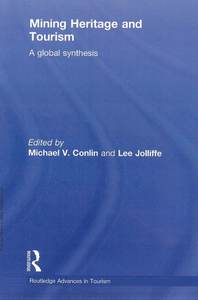From Mining Boom Towns to Tourist Haunts: the ghost town life cycle
Prideaux, Bruce, and Timothy, Dallen J. (2011) From Mining Boom Towns to Tourist Haunts: the ghost town life cycle. In: Conlin, Michael V., and Jolliffe, Lee, (eds.) Mining Heritage and Tourism. Routledge Advances in Tourism . Taylor & Francis, New York, USA, pp. 227-238.
![[img]](https://researchonline.jcu.edu.au/21555/1.hassmallThumbnailVersion/21555_Prideaux_2011_cover.jpg)
|
Image (JPEG) (Book Cover)
- Cover Image
Download (96kB) |
|
|
PDF (Published Version)
- Published Version
Restricted to Repository staff only |
Abstract
[Extract] The term 'ghost town' conveys a sense of abandonment, desertion, dereliction, isolation, decay and even the supernatural. The popular image of a ghost town is one where the former inhabitants have moved away leaving only abandoned buildings as a testament to the community that once stood there. However, this is only one type of ghost town. Factors leading to abandonment include exhaustion of natural resources on which the settlement formerly depended, bypassing by railways or new highways (as in the case of several small towns along Historic Route 66 in the United States), sudden events or disasters, or the shifting of human economic activities to other areas. The most famous, or perhaps infamous, ghost town of the recent past is Chernobyl, Ukraine. A 1986 accident in the Chernobyl nuclear power plant forced the sudden evacuation of thousands of residents. Today, Chernobyl remains a city without residents, a ghost town where entry is tightly controlled because of high radiation levels and other safety hazards.
There are many ghost towns throughout the world that arose when resource extraction or manufacturing ceased. Some of these have become salient tourist attractions for a number of reasons. For example, ghost towns whose settlements were based on timber or mining in mountain regions are often located in areas of natural beauty. There are many such examples in the north-western United States and in the Australian outback and Tasmania. In other cases, they are well-known and visited because of their role as a venue for some famous event or period of history, or their connection to a legendary character (e.g. Tombstone, Arizona). Additionally, others are preserved for their architectural, aesthetic and artistic value, or because they remain relatively intact in their original form (e.g. Bodie, California).
In some cases, tourism has been able to resurrect ghost towns or bring dwindling resource communities from the brink of becoming complete ghost towns (Johansen, 1998). Several examples exist where towns on the verge of abandonment have been reinvented for tourists as ethnic villages (Frenkel et al., 2000) or what Getz (1993) called 'tourist shopping villages' (Frost, 2006; Timothy, 2005), which design themselves as tourist and day-tripper destinations for shopping opportunities combined with heritage sites and resources.
In this chapter a mining ghost town is described as a mining settlement that was abandoned or nearly abandoned after resource extraction ceased. We examine the processes that lead to a settlement being transfonned into a ghost town or reinvented into something else and consider the role that tourism may play in revitalizing the economies of resource-depleted communities.
| Item ID: | 21555 |
|---|---|
| Item Type: | Book Chapter (Research - B1) |
| ISBN: | 978-0-415-56090-0 |
| Date Deposited: | 20 Dec 2012 23:51 |
| FoR Codes: | 15 COMMERCE, MANAGEMENT, TOURISM AND SERVICES > 1506 Tourism > 150605 Tourism Resource Appraisal @ 100% |
| SEO Codes: | 90 COMMERCIAL SERVICES AND TOURISM > 9003 Tourism > 900303 Tourism Infrastructure Development @ 100% |
| Downloads: |
Total: 632 Last 12 Months: 2 |
| More Statistics |



